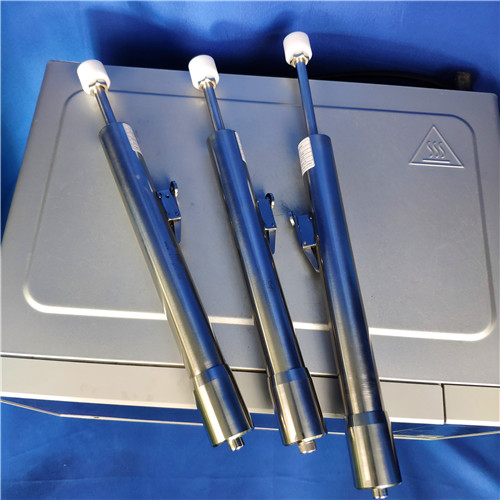





UL923 Microwave Cooking Appliances -Door Assembly Tests
Product Details:
| Place of Origin: | China |
| Brand Name: | KingPo |
| Certification: | Calibration Certificate |
| Model Number: | UL 923 -clause 40.2 |
Payment & Shipping Terms:
| Minimum Order Quantity: | 1 |
|---|---|
| Price: | To be quoted |
| Packaging Details: | safety carton pack or plywood box |
| Delivery Time: | 7 working days |
| Payment Terms: | T/T |
| Supply Ability: | 50 pcs per month |
- Description
- Reviews (0)
Description
Detail Information
Material:Stainless SteelSpring Constant:1 .05 N/mmForce:66N/89N/133N/222NStandard:UL 923High Light:
UL923-Clause 40.2
,
UL923 electrical appliance tester
,
222n electrical appliance tester
Product Description
UL923 Microwave Cooking Appliances -Door Assembly Tests
40 Door Assembly Tests
40.1 Door operation
40.1 .1 The door assembly shall withstand the forces expected during intended usage without affecting the seal to the extent that the equivalent plane wave power density of microwave radiation emitted exceeds 5 mW/cm 2 at any point 5 cm or more from the external surface of the enclosure when subjected to the test in Microwave Radiation Emission Test, Section 34, with all interlocks in the circuit. The door shall remain intact and in place after each applicable test.
40.1 .2 To determine compliance with 40.1 .1 , a complete sample is to be subjected to the applicable tests described in 40.2.1 – 40.5.7 and the microwave radiation emitted then measured as described in 34.2.1 – 34.5.3 after each procedure. Following the appropriate series of impact tests, on inner and outer viewing screen barriers and door seals, the appliance shall be examined for compliance with 5.9. A new sample may be used for each procedure or the same sample may be used with the applicable tests performed in the sequence given. If an unacceptable result occurs on any subsequent test after the first test on a given sample, the test is to be repeated on a new sample and if the results are acceptable, the series of tests
continued until all the required tests have been completed or another unacceptable result occurs.
40.1 .3 When applying the requirements of 40.3.1 and 40.4.1 consideration is to be given to the effect of different installation arrangements (counter-top supported, built-in, and the like), recommended by the manufacturer, upon the maximum force that can be applied to the door without tilting the appliance.
40.2 All doors
40.2.1 Starting at a point midway between the fully open and closed position, the door is to be moved to its fully open position by means of a force equal to 1 .5 times the force necessary to open the door from its closed position, 1 5 lbf (66 N) minimum, applied to the inside surface of a hinged door at a point 1 in (25.4 mm) from the free edge, or to the handle of a sliding door in the direction of intended travel. The opening operation is to be performed ten times on a household appliance and 50 times on a commercial appliance.
40.2.2 Starting at a point midway between the fully open and closed position, the door is to be moved to its fully closed position by means of a force equal to two times the force necessary to close the door to its fully closed and latched position, 20 lbf (89 N) minimum, applied to the outside surface of a hinged door at a point 1 in (25.4 mm) from the free edge or the handle of a sliding door in the direction of intended travel. The closing operation is to be performed ten times on a household appliance and 50 times on a commercial appliance.
40.2.3 In performing the tests described in 40.2.1 and 40.2.2 the force for opening and closing the door is to be obtained by means of a spring scale or equivalent having a spring constant of 6 lbf/in (1 .05 N/mm).
The force is to be applied to the designated location on the door with a restraining force applied opposite and collinear with the actuating force. The restraining force is then removed to allow the door to complete its opening or closing by means of the spring-applied impulse.
40.3 Side-hinged doors
40.3.1 A side-hinged door is to be moved to its fully open position and then closed with a force equal to 50 lbf (222 N), or the maximum force that can be applied to the door without tilting the appliance,whichever is smaller, supported at the free edge of the door. The opening and closing operation is to be performed five times for a household appliance and ten times for a commercial appliance.
40.4 Bottom-hinged doors
40.4.1 A bottom-hinged door of a counter- or table-supported appliance is to be subjected for 1 5 min to a force of 50 lbf (222 N) or the maximum force that can be applied without tilting the appliance, whichever is smaller, applied to the inside surface of the open door at a point 1 in (25.4 mm) from the free edge. For a floor-supported household appliance, the applied force is to be 1 00 lbf (445 N) or the maximum weight the appliance can support without tilting, whichever is smaller. For a floor-supported commercial appliance the applied force is to be 1 50 lbf (667 N) or the maximum force that can be applied without tilting, whichever is smaller.
40.4.2 A bottom-hinged door is to be closed as far as possible with a 3/8-in (9.5-mm) diameter hardwood dowel placed between the lower inside surface of the door and the mating surface of the enclosure below the oven cavity. The dowel is to be oriented in the position that will cause the most adverse effect. The closing force is to be 20 lbf (89 N) for a household oven and 30 lbf (1 33 N) for a commercial oven and is to be applied to the door handle for 5 s.











Reviews
There are no reviews yet.